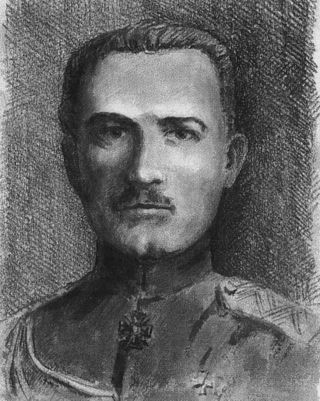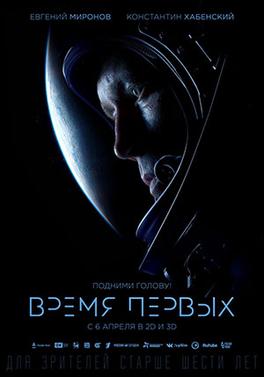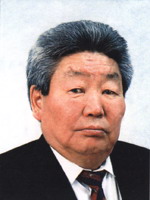Related Research Articles

Vladimir Mikhaylovich Komarov was a Soviet test pilot, aerospace engineer, and cosmonaut. In October 1964, he commanded Voskhod 1, the first spaceflight to carry more than one crew member. He became the first Soviet cosmonaut to fly in space twice when he was selected as the solo pilot of Soyuz 1, its first crewed test flight. A parachute failure caused his Soyuz capsule to crash into the ground after re-entry on 24 April 1967, making him the first human to die in a space flight.

Salyut 3 was a Soviet space station launched on 25 June 1974. It was the second Almaz military space station, and the first such station to be launched successfully. It was included in the Salyut program to disguise its true military nature. Due to the military nature of the station, the Soviet Union was reluctant to release information about its design, and about the missions relating to the station.

Vasily Grigoryevich Zaitsev was a Soviet sniper during World War II.

Enemy at the Gates is a 2001 war film directed, co-written, and produced by Jean-Jacques Annaud, based on William Craig's 1973 nonfiction book Enemy at the Gates: The Battle for Stalingrad, which describes the events surrounding the Battle of Stalingrad in the winter of 1942–1943. The screenplay was written by Annaud and Alain Godard. The film's main character is a fictionalized version of Vasily Zaitsev, a sniper and Hero of the Soviet Union during World War II. It includes a snipers' duel between Zaitsev and a Wehrmacht sniper school director, Major Erwin König.

Elbe Day, April 25, 1945, is the day Soviet and American troops met at the Elbe River, near Torgau in Germany, marking an important step toward the end of World War II in Europe. This contact between the Soviets, advancing from the east, and the Americans, advancing from the west, meant that the two powers had effectively cut Germany in two.

Kazimierz Porębski was a Polish career naval officer who rose to the position of admiral within the Imperial Russian Navy and was subsequently the first commander-in-chief of the inter-war Polish Navy.

The Russian All-Military Union is a White movement organization that was founded by White Army General Pyotr Wrangel in the Kingdom of Serbs, Croats and Slovenes on 1 September 1924. It was initially headquartered in the town of Sremski Karlovci. The organization′s ostensible purpose was providing aid to the veterans of the Russian White movement, soldiers and officers alike, who had moved outside the Soviet Union.

The Russian Protective Corps was an armed force composed of anti-communist White Russian émigrés that was raised in the German occupied territory of Serbia during World War II. Commanded for almost its whole existence by Lieutenant General Boris Shteifon, it served primarily as a guard force for factories and mines between late 1941 and early 1944, initially as the "Separate Russian Corps" then Russian Factory Protective Group. It was incorporated into the Wehrmacht on 1 December 1942 and later clashed with the communist-led Yugoslav Partisans and briefly with the Chetniks. In late 1944, it fought against the Red Army during the Belgrade Offensive, later withdrawing to Bosnia and Slovenia as the German forces retreated from Yugoslavia and Greece. After Shteifon′s death in Zagreb, the Independent State of Croatia, on 30 April 1945, Russian Colonel Anatoly Rogozhin took over and led his troops farther north to surrender to the British in southern Austria. Unlike most other Russian formations that fought for Nazi Germany, Rogozhin and his men, who were not formally treated as Soviet citizens, were exempt from forced repatriation to the Soviet Union and were eventually set free and allowed to resettle in the West.

Boris Aleksandrovich Shteifon was a Russian lieutenant general in the Imperial Russian Army, who subsequently served as a general in the anti-communist White Army, and as the leader of the Nazi-allied Russian Corps in the German occupied territory of Serbia during World War II in Yugoslavia.

Police Academy: Mission to Moscow is a 1994 American action comedy film starring George Gaynes, Michael Winslow, David Graf, and Claire Forlani. The film was directed by Alan Metter and written by Randolph Davis and Michele S. Chodos. The seventh installment in the Police Academy franchise, sequel to Police Academy 6: City Under Siege, cast members Gaynes, Winslow, and Graf appear in all seven films.

Ivan Mikhailovich Sidorenko was a Red Army officer and a Hero of the Soviet Union, who served during World War II. He was one of the top Soviet snipers in the war, with five hundred confirmed kills.

Lieutenant-Commander Lionel Kenneth Phillip Crabb,, known as Buster Crabb, was a Royal Navy frogman and diver who vanished during a reconnaissance mission for MI6 around a Soviet Union cruiser berthed at Portsmouth Dockyard in 1956.

Karl-Heinz Kurras was a West German police inspector, known primarily for fatally shooting unarmed student Benno Ohnesorg in the back of the head during a demonstration on 2 June 1967, outside Deutsche Oper against the state visit of Mohammad Reza Pahlavi, the last Shah of Iran. Kurras was acquitted of any wrongdoing in a series of controversial trials, due to which he became a prominent hate figure of the left-wing German student movement of the 1960s as well as the German New Left. They suspected that Kurras was under protection from many right-wing figures in the West German police and justice system and who were resentful towards the left-wing students. The incident is considered pivotal for the rise of left-wing terrorism in West Germany during the 1970s, culminating with the Movement 2 June and the Red Army Faction.

Only "Old Men" Are Going Into Battle is an iconic 1973 Soviet war drama black-and-white film produced in the USSR about World War II fighter pilots, written and directed by Leonid Bykov, who also played the lead role as the squadron commander.

72 Meters is a 2004 Russian disaster film directed by Vladimir Khotinenko based on the short stories from the collection of stories of the same name by Alexander Pokrovsky.

Retrospective Exhibition "Painting of 1940–1990s. The Leningrad School" was one of the most notable events in the Saint Petersburg exhibition live of 1996. The exhibition took place at the Memorial Museum of Nikolai A. Nekrasov.

The Age of Pioneers, also known as Spacewalk or The Spacewalker, is a Russian historical drama film about cosmonaut Alexei Leonov, the first human to perform a spacewalk. Leonov himself served as a consultant for the film. The Age of Pioneers was directed by Dmitry Kiselyov and co-produced by Timur Bekmambetov and Yevgeny Mironov, the latter also starred in the leading role.
The Aerial Cabman is a 1943 Soviet musical comedy film directed by Gerbert Rappaport.
I Am a Sailor of the Black Sea Fleet, is a 1944 Soviet World War II film directed by Aleksander Macheret and Vladimir Braun.

Mikhail Innokentyevich Semyonov was a Soviet and Russian industrialist and politician.